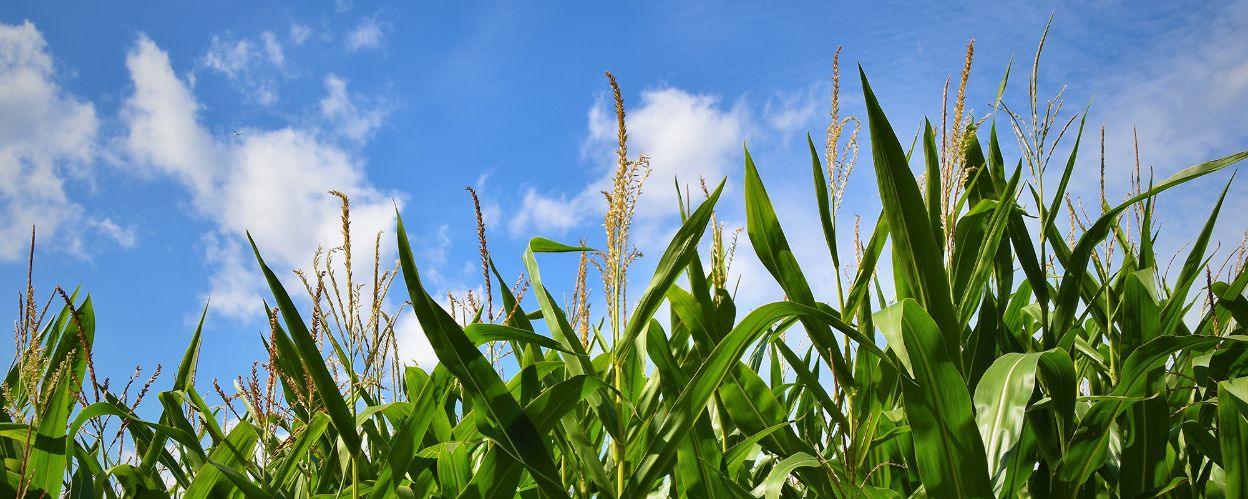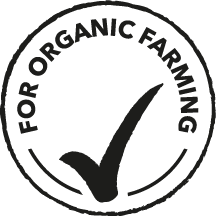
Corn
Corn is a high-performance plant; in our latitudes, harvests of over 50 tonnes of silage corn or over 10 tonnes of grain corn are possible in good weather conditions. Anyone who wants to achieve these yields can only do so if they know exactly what nutrient requirements corn has at what time. This is because the plants only have the short time from mid-June to the end of July to build up three quarters of their biomass. Traditionally used as silage or grain corn, its importance as a renewable raw material is increasing.
The corn needs optimal nutrient management for rapid growth
Corn has the highest daily growth rate of all native crops. In temperate latitudes, corn is able to convert light energy into biomass most effectively. For optimum growth, it needs to draw from the full range of nutrients.
- Potassium is the foundation of high and safe corn yields.
- High assimilation performance and full cobs due to magnesium.
- Sulfur is more important than ever for nutrient efficiency.
- Boron, manganese, zinc, and copper – micronutrients with a big impact.
Corn – the high performance crop
There are versatile uses for the corn plant. Besides its traditional use as silage or grain corn and as a silage plant, its importance as a renewable raw material is increasing. Here, corn is used in biogas plants as well as an oil binder, packaging, or shock protection material.
What makes corn a high-performance crop?
- The corn plant shows the highest breeding progress.
- Corn converts light energy into yield very effectively.
- Corn has the highest daily biomass gain, producing high green mass yields in the shortest time.
- Corn has the ability to convert high amounts of nutrients into yield and valuable ingredients.
Optimal fertilization is therefore crucial to meet the performance potential.
The most important nutrients for corn

Potassium – the basis for reliable corn yields
- A corn crop absorbs an average of 240kg of K2O per hectare within a few weeks – until the flag leaf push at the end of July.
- Potassium (K) from liquid manure is often not sufficient to meet yield expectations.
- Mineral potassium fertilization leads to visibly better stands even under unfavorable growing conditions.
- High potassium availability in the main growing season ensures sturdy corn, pushes back stem rot and therefore prevents crop heaviness and yield losses due to lodging.
- Optimal potassium effect is only given in combination with the nutrient magnesium (Mg).
Magnesium – for full corn cobs
The magnesium requirement of the corn plant is 50-70kg/ha MgO. About two thirds of this is absorbed within 4 to 6 weeks, between row closure and flowering. The following parameters must be taken into account:
- The potassium/magnesium ratio in the soil should not exceed 2:1 to ensure optimal magnesium supply.
- Liquid manure alone, with a K/Mg ratio of 4.5:1, cannot ensure magnesium supply.
- A good magnesium supply ensures a high chlorophyll content in the leaves, which ensures the performance of the corn stand.
- High assimilation performance and improved removal of assimilates are fundamentals of full grain formation.
Sulfur – for protein formation and nitrogen efficiency
Sulfur activates important enzymes in energy and fatty acid metabolism. It is essential for the synthesis of sulfur-containing amino acids, influences overall protein synthesis and therefore has a positive effect on yield.
An optimal sulfur supply leads to efficient nitrogen utilization. This is because in the case of sulfur deficiency, the nitrogen taken up cannot be converted into proteins and a signal is sent to the roots to take up less nitrogen. Thus, to make optimal use of nitrogen, the plant's need for sulfur must be met.
Sulfur enables the corn plant to maintain its physiological processes optimally even under drought stress and to avoid or at least minimize yield losses. Sulfur is a component of the metabolic product glutathione, which, as an antioxidant, renders oxygen radicals formed during drought stress harmless and therefore prevents necrosis of the leaves.
Targeting yield reserves in corn with boron and manganese
Boron
- Corn is one of the crops in particular need of boron (150-200g/ha boron).
- The supply of the crop via liquid manure (2g/ha boron) is completely insufficient.
- Boron is responsible for the smooth transportation of the sugars formed and for subsequent starch synthesis.
- Boron promotes the establishment and formation of cobs and grain.
- For optimum formation of the grain rows and cob, sufficient boron must be available from the 4- to 10-leaf stage.
- A good boron supply therefore shifts the corn yield in favor of the grain or cob content and therefore improves feed quality by increasing energy content or market value.
Manganese
- Like magnesium, manganese plays a key role in chlorophyll and photosynthesis.
- This can ensure optimal assimilation of the corn plant, which has a positive effect on yield.
- Manganese promotes the growth of lateral roots and therefore improves nutrient uptake from the soil.
- Only a well-supplied crop can achieve its yield potential.
- For avoiding nutrient competition, a manganese foliar fertilization should always be combined with magnesium.
Fertilizer recommendations for corn
Fertilizer is applied in order to maintain the fertility of the soil so that its natural yield potential can be protected over the long term. This requires the maintenance of an optimal nutrient content in the soil. Nutrients removed with the harvest have to be replaced through an adequate application of fertilizer. Together with the replacement of removed nutrients adjustments have to be added for site specific losses (for example: leaching or erosion).
The total removal of a plant results from the nutrient uptake of the main crop (e.g. grain, tubers or beets) and the uptake of harvest residues (e.g. straw, leaves). If the harvest residues remain on the field, only the removed nutrients by the main crops have to be replaced.
Recommendation for soil fertilization
The table shows fertilizer recommendations calculated on the nutrient uptake of the main crops on base of an optimal soil nutrient content. Adjustments for site-specific losses due to leaching, fixation or erosion are not taken into consideration.
At 9t yield of grain and silage corn, the following fertilizer application is measured for nutrient removal at optimum nutrient soil content class per hectare based on total removal and removal by main kernel products:
|
Total removal (incl. harves residues) 230kg/ha K2O, 61kg/ha MgO, 16kg/ha S
|
|
|
Energy maize 370kg/ha K2O, 50kg/ha MgO und 25kg/ha S |
|
|
Removal through main crop 50kg/ha K2O, 31kg/ha MgO, 10kg/ha S |
|
Product recommendation
Recommendation for foliar fertilization
Product Recommendations
epsoMICROTOP or epsoCOMBITOP for micronutrient supply. We recommend approx. 25 to 40kg/ha as a 5% solution (5kg per 100l water) during the 4-10 leaf stage; split applications could be considered. Alternatively we recommend epsoPROFITOP (with copper, manganese and zinc) approx. 10-20kg/ha (1-2x10kg/ha) at 4 to 12 leaf stage.
epsoBORTOP for an efficient boron supply. We recommend 10kg/ha (1-2x applications) after 6 leaf stage.







